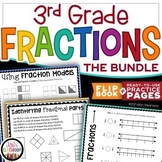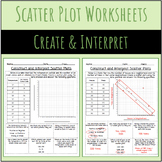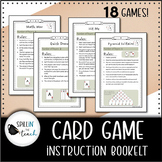35 results
9th grade precalculus laboratories

Make Multiple Vectors Fun! Pirate Treasure Hunt - Physics, Trigonometry
This is one of my student’s favorite activities. Who doesn’t want to go outside and map out some vectors? It works well in physics or trigonometry for understanding how to add and subtract multiple vectors. 10 different maps are provided for student groups to make their way from a single point of origin to a designated, X-marks-the-spot, using compass headings of N, S, E, and W and specified distances. The groups all have a different path but end up at the same place. At the end, students dr
Subjects:
Grades:
8th - 12th, Higher Education, Adult Education
Types:
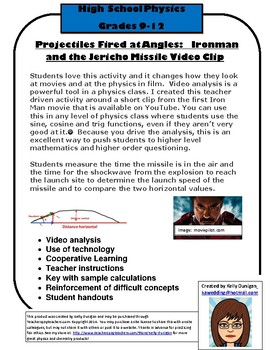
Projectile Motion Video Analysis Jericho Missile Iron Man
Students love this activity and it changes how they look at movies and at the physics in film. Video analysis is a powerful tool in a physics class and your students will look forward to the next one.
I created this teacher driven activity around a short clip from the first Iron Man movie that is available on YouTube. You can use this in any level of physics class where students use the sine, cosine and trig functions, even if they aren’t very good at it. Because you drive the analysis, thi
Subjects:
Grades:
9th - 12th, Higher Education
Types:
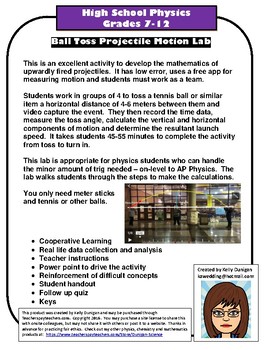
Ball Toss Projectile Motion Activity - On Level, Trig Based or AP Physics
This is an excellent activity to develop the mathematics of upwardly fired projectiles. It has low error, uses a free app for measuring motion and students must work as a team.Students work in groups of 4 to toss a tennis ball or similar item a horizontal distance of 4-6 meters between them and video capture the event. They then record the time data, measure the toss angle, calculate the vertical and horizontal components of motion and determine the resultant launch speed. It takes students 4
Subjects:
Grades:
9th - 12th
Types:
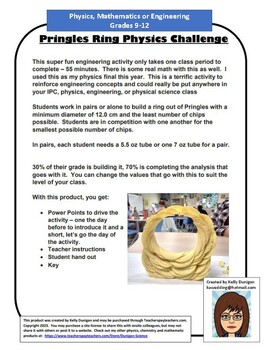
Pringles Ring Physics Challenge
This super fun engineering activity only takes one class period to complete – 55 minutes. There is some real math with this as well. I used this as my physics final this year. This is a terrific activity to reinforce engineering concepts and could really be put anywhere in your IPC, physics, engineering, or physical science class Students work in pairs or alone to build a vertical ring out of Pringles Chips/Crisps with a minimum diameter of 12.0 cm and the least number of chips possible. Student
Subjects:
Grades:
9th - 12th
Types:
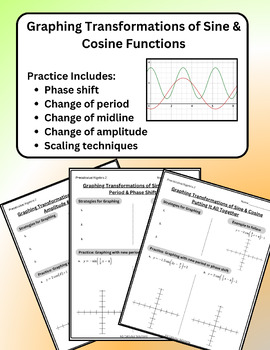
Transforming Sine & Cosine Graphs - Practice / Lesson / Worksheet
Help students learn how to graph all the transformations of the sine and cosine graphs using this interactive practice guide. The practice includes how to adjust the graph's period, amplitude, midline, phase shift and strategies for coming up with a proper scale for each tick mark on the x-axis. A comprehensive answer key is included in the packet along with some sample strategies to teach to students if needed. This lesson corresponds to AP Precalculus Sections 3-4, 3-5 and 3-6
Subjects:
Grades:
9th - 12th
Also included in: Transforming Sine, Cosine, Tangent, Secant, Cosecant, Cotangent BUNDLE
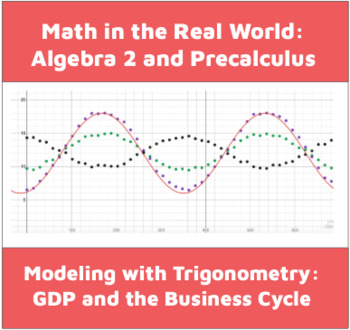
Modeling the Business Cycle with Trig Functions: Activity and Data Set
In this lab, students analyze GDP data from five fictional countries. To complete the activity, students:-- create scatterplots of their data using desmos.com/calculator (or other graphing utility)-- use their data sets to compute the parameters of underlying sinusoidal functions and use Desmos to compare their estimates to the data sets-- interpret the parameters of their equations in context by describing how the economies of each country compare and contrast to each other.-- are challenged to
Subjects:
Grades:
9th - 12th
CCSS:

Vector Treasure Hunt
This activity is designed to teach the students about displacement vectors. There are three parts in four pages. In part II of the lab students make a hunt for other students to follow based on vectors. The next day, students go out, follow the directions and find the "treasure". Very fun activity that teaches the students the basics of vectors. Appropriate for grades 7-12 with an emphasis on beginning physics students.
Subjects:
Grades:
7th - 12th
Types:

Vertical Motion Mouse Trap Project
Students will create mouse trap catapults from mouse traps, craft sticks, plastic spoons and duct tape. Students will launch ping pong balls and record initial height, time and distance for 9 trials. They will then find the average air time and average distance. Next, they will substitute in their average time (t), initial height (c), and end height (h) into the equation h=-16t² + vt + c and solve for v, for each of the 9 trials & average. Once they have their initial velocity they substitu
Subjects:
Grades:
9th - 12th
Types:
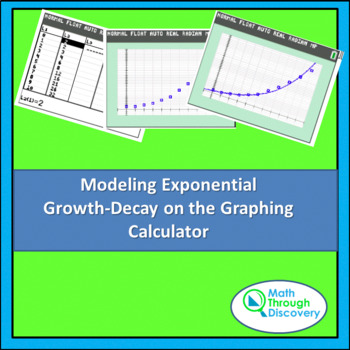
Alg 1 - Modeling Exponential Growth-Decay on the Graphing Calculator
This is a graphing calculator activity that will engage the students in collecting data on both exponential growth and decay using M&Ms. The graphing calculator is used to create scatter plots and equations that represent both situations from the data collected.In part I the students, after students have collected data using the M&M’s students are guided at entering the data into their graphing calculators. Screen shots guide and assist the students in the calculator steps. When they h
Subjects:
Grades:
9th - 12th
Types:
CCSS:
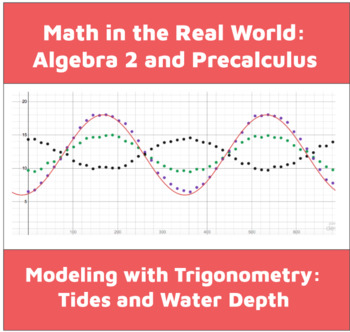
Modeling Tides with Trigonometric Functions
In this activity, students analyze data sets about water depth through the daily tidal cycle. While completing this activity, students:-- create scatterplots using desmos.com/calculator-- practice computing the parameters of sinusoidal functions and check their work by fitting an equation to the scatterplot-- interpret the meaning of different parameters in context-- determine how a verbal description of changes to the environment would impact parameter values-- introduce a new term to a basic s
Subjects:
Grades:
9th - 12th
CCSS:
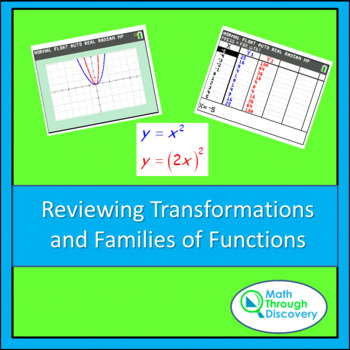
Alg 2 - Reviewing Transformations and Families of Functions
This activity engages the students in reviewing transformations on a function such as scalar multiples, vertical and horizontal shifts, and taking absolute value of domains and ranges. In the first part students • Compare the graphs and a set of table values for y=f(x) and y=f(ax). Make a statement about the effect a has on the functions.• Compare the graphs and a set of table values for y=f(x) and y=af(x). Make a statement about the effect a has on the functions.• Compare the graphs and a
Subjects:
Grades:
9th - 12th
Types:

Clinometer Discovery Lab (Using Trigonometry)
I gave this project to both geometry and PreCalculus students. I gave them specific directions (included) on how to make a clinometer, but taught them nothing else about how to use them. They had to figure out how to use trigonometry to find the height of some objects in our commons (on a nice day, it would be awesome to go outside). Students used a lot of trial and error, and found how important it was to have an accurate diagram. I checked in frequently with each group-common errors included n
Subjects:
Grades:
8th - 12th
Types:
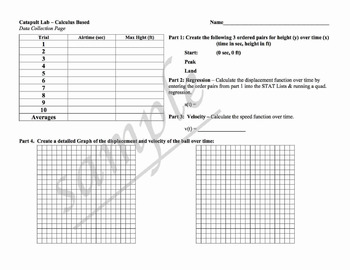
Polynomial Labs (Quadratics, Cubics, etc.) including Catapults!
This lab includes two versions of a catapult lab (calculus based and non-calculus based). Students work in groups to collect data on a ball launched using a catapult. Students create regression equations using a graphing calculator or spreadsheet.
Also included is a painted cubes lab that includes 4 types of functions.
Courses: algebra 1, algebra 2, pre-calculus, calculus
Here are links to my other algebra projects:
Click Here to see my project: Indirect Measurement Labs
Click Here to see
Subjects:
Grades:
8th - 12th, Higher Education, Adult Education
Types:
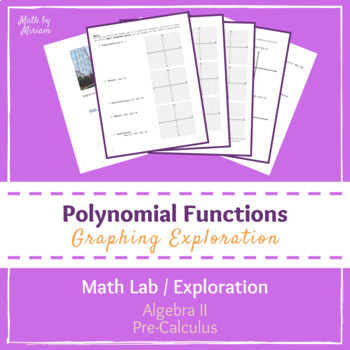
Polynomial Functions Exploration (PrBL PBL Activity)
This lab is designed to 1) introduce the relationship between a function rule, written in intercept form, and the zeros on a graph for all polynomial functions & introduce the concept of end behavior 2) allow students an opportunity to review multiplying polynomials and plotting coordinates precisely by hand. My students were lacking a strong Algebra 2 foundation so I designed this lab for them to raise them up to Pre-Calculus concepts (polynomial behaviors based on the way the function rule
Subjects:
Grades:
9th - 12th
Types:
CCSS:
Also included in: Polynomial Functions Resource Bundle (PrBL PBL Unit)
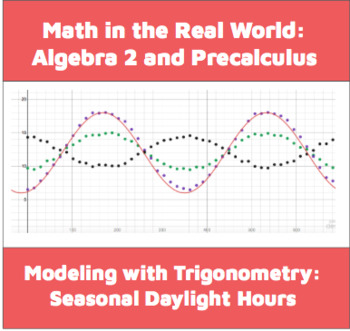
Modeling Seasonal Daylight Length with Trig Functions
In this activity, students analyze data sets modeling hours of sunlight in three cities over the course of the year (Sydney, Juneau, and Washington D.C.) To complete the activity, students must:-- practice computing the parameters of sinusoidal functions and check their work by fitting an equation to the scatterplot-- use their equations to predict the hours of sunlight on specific days of the year-- use their graphs and equations to predict when pairs of cities will have the same amount of sunl
Subjects:
Grades:
9th - 12th
CCSS:
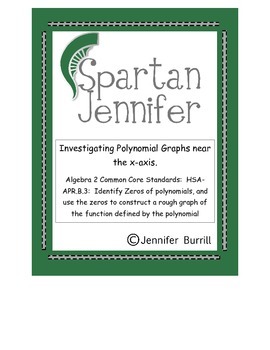
Investigating Graphs Behavior Near Zero
This is a polynomial graphing investigation looking at multiplicities of zeros and what that does to the graph. You will need access to graphing calculators for your students (or you can use desmos.com) and demonstrate the four graphs on the front page. This will have the students look at four different graphs and relate the multiplicities with whether the graph crosses the x-axis or just touches the x-axis. Then as a conclusion to the investigation they will sketch a rough graph using only t
Subjects:
Grades:
9th - 12th
Types:
CCSS:

Math Lab:Exponential Functions and Seed Overproduction vs Time/DISTANCE LEARNING
My students totally enjoy doing the following math lab! They invariably find it to be both fun to do as well as informative. They readily relate to discussions within.
* Students work with a partner
* Students begin by a brief discussion about seed overproduction
* Students are provided with assumptions used to complete the lab
* Students work collaboratively to determine the number of seeds in a bell pepper
* Students find the average number of seeds in a bell pepper using the totals
Subjects:
Grades:
7th - 11th, Higher Education, Adult Education
Types:

Exponential Logarithm Trigonometric Activities and Labs
This project set includes 8 projects that are cooperative learning, hands-on labs. Students collect data that fit exponential, logarithmic, or trigonometric patterns. Students will create equations from the data and use the equations to make predictions. Many of the equations students create will be through the regression process on graphing calculators or spreadsheets.
classes: algebra 2, pre-calculus, calculus, applied math
Here are links to my other algebra projects:
Click Here to see m
Subjects:
Grades:
9th - 12th, Higher Education, Adult Education
Types:
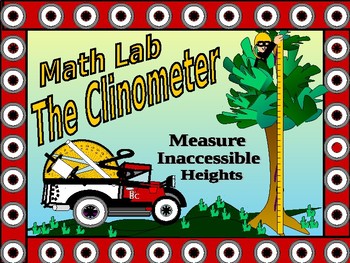
Math Lab: The Tangent Ratio, a Clinometer, and Inaccessible Heights
The following math lab is a follow-up to lessons on the Trigonometric Ratios:* In the lab, students follow steps to create a measuring device called The Clinometer* Students use the Clinometer to measure objects of inaccessible heights such as trees or flag poles.* To measure the objects, students use their Clinometer and apply the Tangent Ratio.* Students work with a partner. * One partner looks through the Clinometer while the other partner records the data required to calculate the tange
Subjects:
Grades:
7th - 11th, Higher Education, Adult Education
Types:
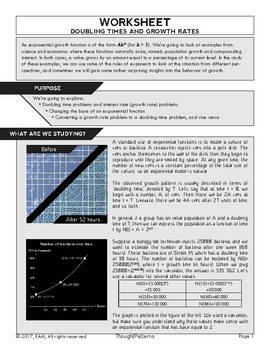
Lab - Exponential functions: Doubling times and growth rates
This is a lab that I have used for years to teach my students about exponential functions. It is quite large, and I usually assign it as a major project. If a student can work through the entire lab on his or her own, that student should have no problems with the unit test. I touch on applications from biology, economics, and chemistry; so that the subject doesn't seem like a dry mathematical topic.
Subjects:
Grades:
9th - 12th, Adult Education
Types:
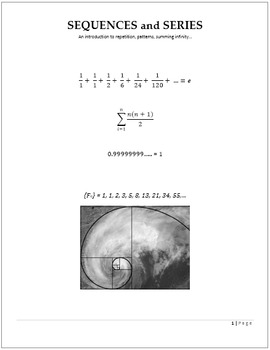
Intro to Sequences and Series Unit
This packet will introduce your students to sequences and series.
It will provide them with many of the useful vocabulary terms.
Introduce them to general, arithmetic, geometric, finite, and infinite sequences and series.
It will instruct them on how to write recursive and explicit formulas, sigma notation for series, tests for convergence of infinite geometric sequences and series, and evaluating finite and infinite arithmetic and geometric series.
This should cover nearly all the material tra
Subjects:
Grades:
8th - 12th
Types:

Modeling Length of Daylight Hours with Trig Functions
In this activity, students analyze data sets modeling hours of sunlight in three cities over the course of the year (Sydney, Juneau, and Washington D.C.) To complete the activity, students must:-- practice computing the parameters of sinusoidal functions and check their work by fitting an equation to the scatterplot-- use their equations to predict the hours of sunlight on specific days of the year-- use their graphs and equations to predict when pairs of cities will have the same amount of sunl
Subjects:
Grades:
9th - 12th
CCSS:
Also included in: Modeling Seasonal Daylight Length with Trig Functions
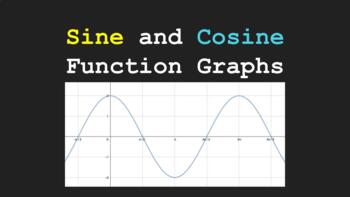
Discovering Sine and Cosine Function Graphs
In this activity, students will use a linked Geogebra to explore the graphs of sine and cosine functions. They will manipulate the amplitude, the period, the phase shift, and the vertical shift parameters to determine how changing those parameters in the function affects its graph. They will reflect on how the algebra of the function relates to its geometry. They will then reflect upon what they have done by coming up with an equation for the period of the functions, exploring the sine/cosine
Subjects:
Grades:
9th - 12th, Higher Education
CCSS:

Modeling Tides with Trig Functions
In this activity, students analyze data sets about water depth through the daily tidal cycle. While completing this activity, students:-- practice computing the parameters of sinusoidal functions and check their work by fitting an equation to the scatterplot-- interpret the meaning of different parameters in context-- determine how a verbal description of changes to the environment would impact parameter values-- introduce a new term to a basic sinusoidal function to incorporate changes in globa
Subjects:
Grades:
9th - 12th
Also included in: Modeling Tides with Trigonometric Functions
Showing 1-24 of 35 results

